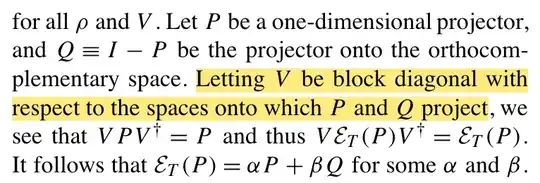The twirled operation of a quantum channel $\mathcal E$ is defined as \begin{align} \mathcal E_T(\rho) &= \int dU U^\dagger \mathcal E(U \rho U^\dagger)U, \end{align} where the integral is over the normalized Haar measure $dU$.
Let $P$ be a one-dimensional projector, and $Q \equiv I − P$ be the projector onto the orthocomplementary space. Letting $V$ be block diagonal with respect to the spaces onto which $P$ and $Q$ project, we see that $V P V^\dagger = P$ and thus $V \mathcal E_T (P )V^\dagger = \mathcal E_T (P)$. How to prove that $\mathcal E_T(P) = \alpha P+ \beta Q$ for some $\alpha$ and $\beta$?
This result was in this article by Nielsen.

> quoteblocks to quote text – glS Mar 27 '23 at 12:25